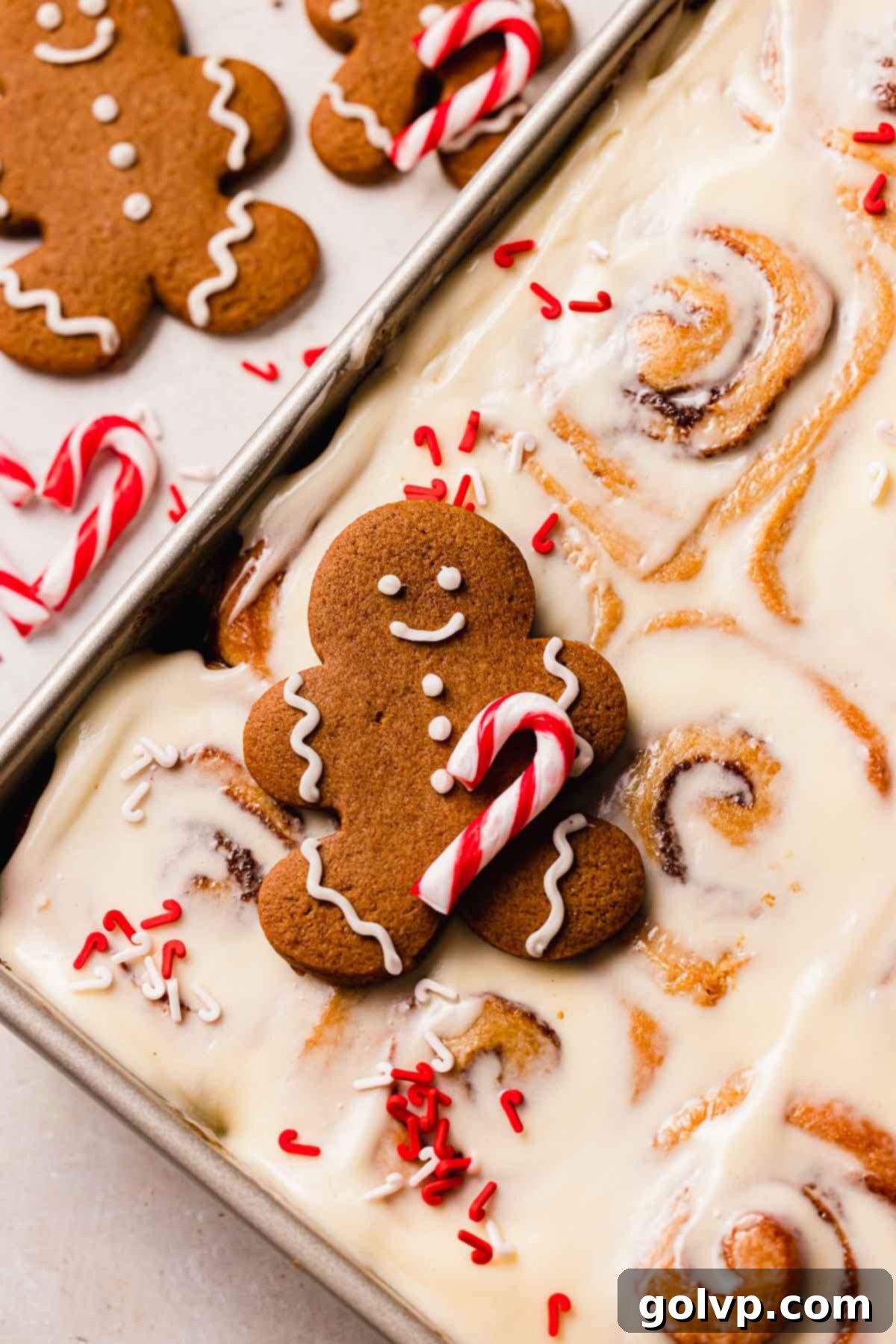Ultimate No-Knead Gingerbread Cinnamon Rolls: Ultra Gooey & Festive for the Holidays
Prepare to be enchanted by these incredible gingerbread cinnamon rolls, a truly spectacular holiday treat. Each roll is incredibly soft, delightfully fluffy, and boasts an ultra-gooey center, all thanks to a rich, easy-to-make gingerbread filling. Crowned with a luxurious classic cream cheese frosting, these rolls are infused with the authentic taste of gingerbread, featuring deep, warm molasses notes and a symphony of festive spices. The best part? The dough is a simple, no-knead wonder that comes together effortlessly, requiring no electric mixer. These aren’t just cinnamon rolls; they’re a celebration in every bite, perfect for your holiday brunch, Christmas morning, or any festive gathering. Plus, with a convenient make-ahead option, you can prepare them the night before and wake up to freshly baked holiday magic!
I’ve meticulously updated this beloved recipe to ensure the rolls are even fluffier, more flavorful, and undeniably gooey than ever before. For an ultimate holiday experience, enjoy them warm alongside this quick and easy gingerbread latte.
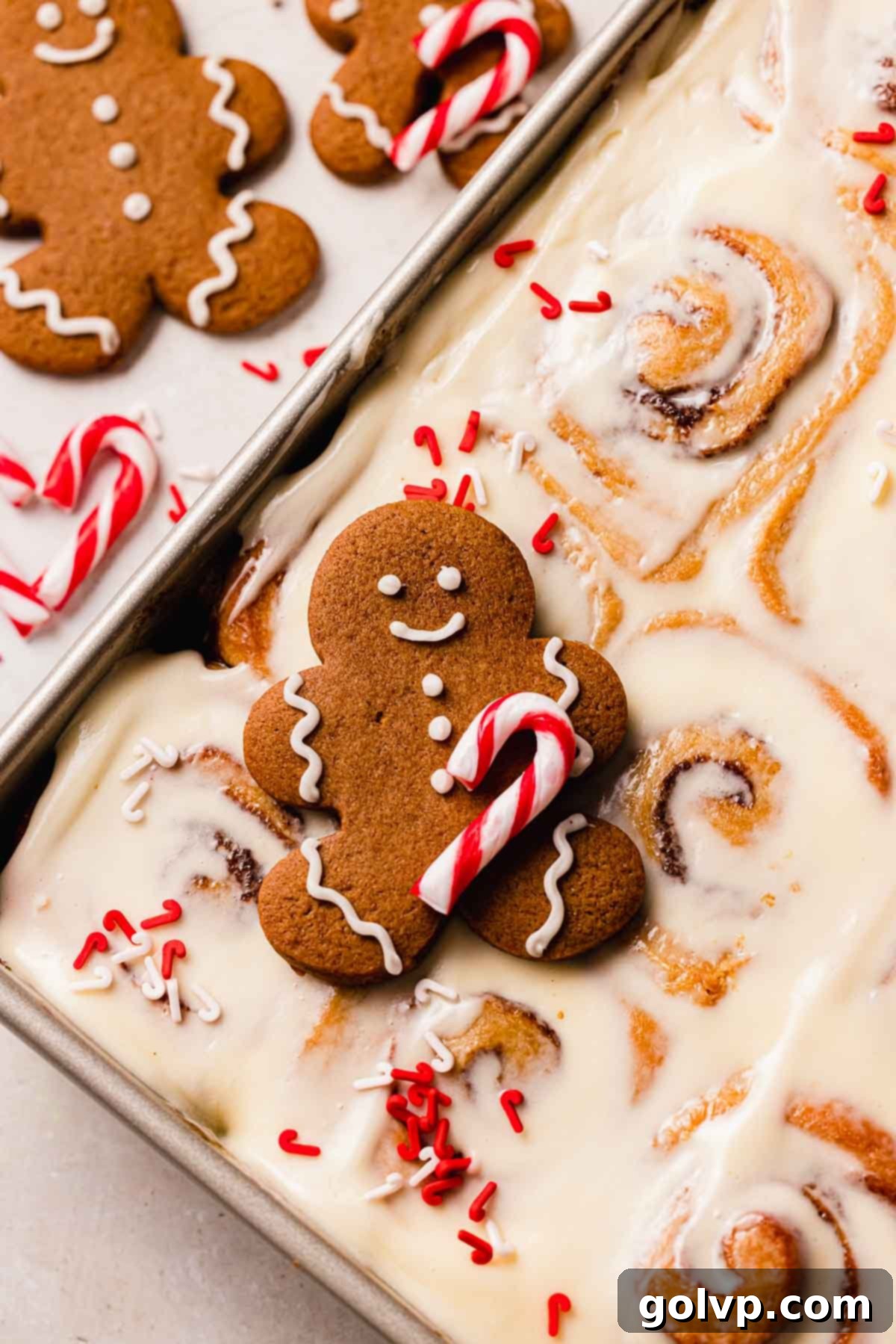
[feast_advanced_jump_to]
☃️ Why You’ll Absolutely LOVE These Gingerbread Rolls
- Irresistibly Flavorful Filling: The heart of these rolls is a generously spiced gingerbread filling, crafted with a perfect blend of brown sugar, molasses, and warm winter spices. This isn’t just a sweet layer; it’s the secret to their deep flavor and incredibly gooey texture, making each bite an unforgettable experience.
- Unbeatably Gooey & Fluffy: Say goodbye to dry, dense cinnamon rolls! Our special trick involves pouring heavy cream over the rolls just before baking. This creates a steamy environment in the oven, ensuring the rolls are unbelievably moist, fluffy, and have those coveted sticky, gooey bottoms that are simply divine.
- Surprisingly Easy, No-Knead Dough: Don’t let the impressive results intimidate you. This recipe features a beginner-friendly, no-knead dough that requires minimal effort. Simply stir all the ingredients together in a bowl, let it rise, and it’s ready to be rolled out. No heavy-duty mixer or complicated kneading techniques required, making it perfect for bakers of all skill levels.
- The Epitome of Festive: With their inviting aroma and classic gingerbread taste, these cinnamon rolls are the ultimate holiday indulgence. They’re perfectly suited for a festive Christmas brunch, a cozy holiday morning breakfast, or as a show-stopping dessert to bring to your next seasonal gathering. They instantly elevate any occasion!
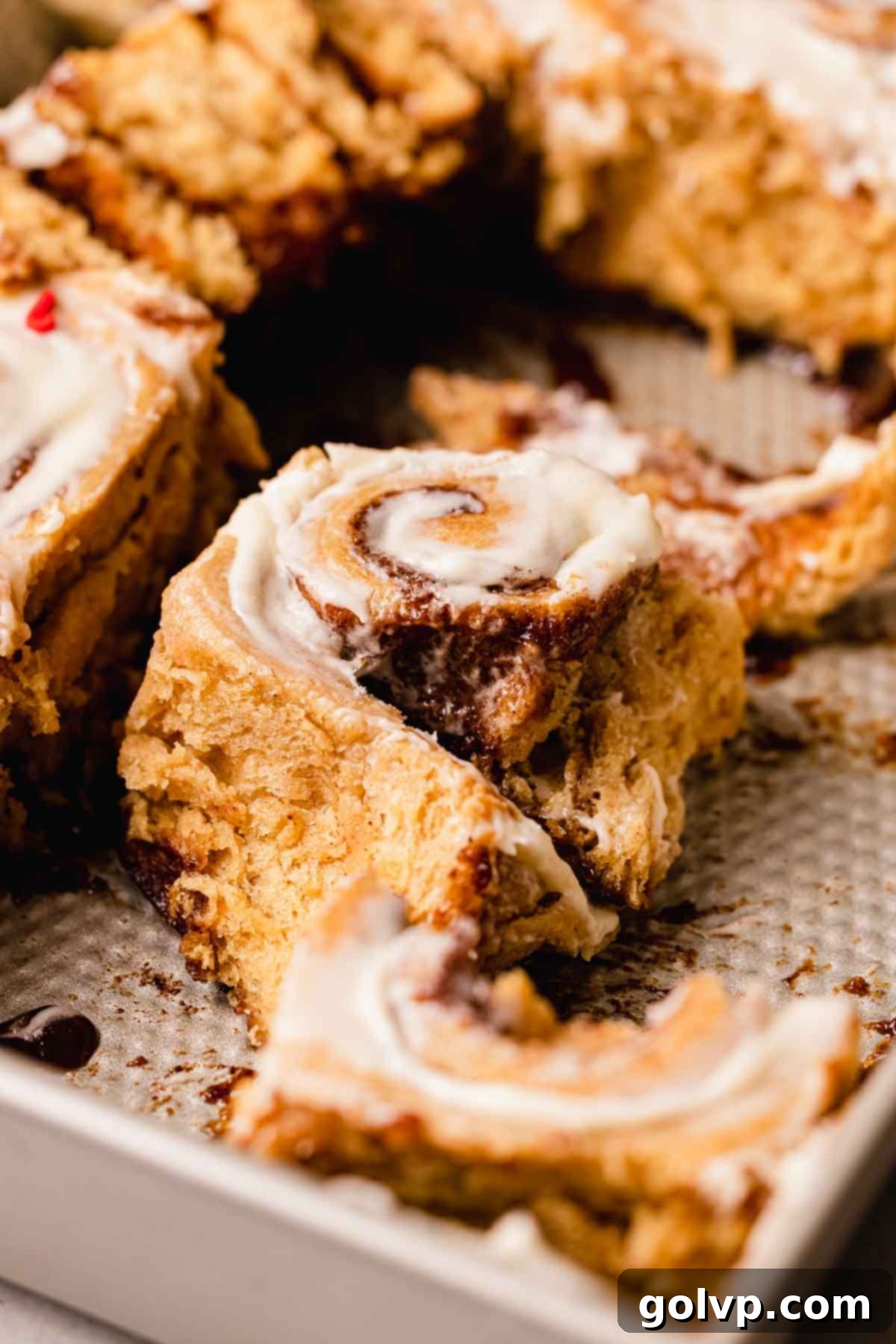
📝 Key Ingredients for Perfect Gingerbread Cinnamon Rolls
For flawless gingerbread cinnamon rolls, pay close attention to these key ingredients and tips for their use.
Find the full list of steps and exact ingredient measurements in the recipe card below.
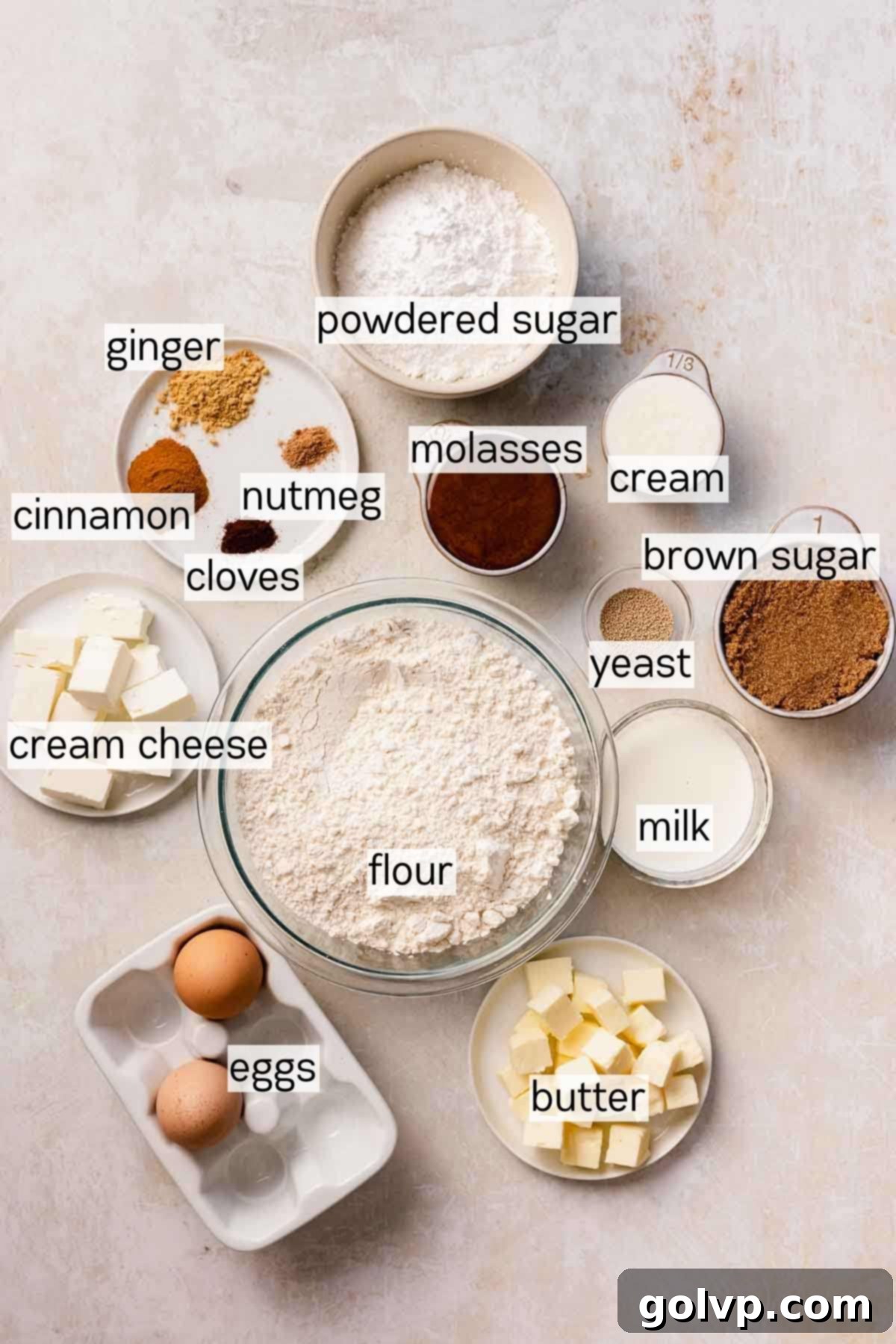
- Fresh Spices: Ginger, Cinnamon, Cloves, Nutmeg: The vibrant flavor of gingerbread comes from these aromatic spices. For the best results, ensure your spices are fresh and haven’t been sitting in your pantry for ages, as they lose potency over time. Storing them in airtight containers away from direct light and heat helps maintain their freshness and robust flavor longer. Freshly ground spices, if possible, will make an even bigger difference!
- Molasses: Dark molasses is my absolute top recommendation for this recipe. It provides that signature deep, slightly smoky, and rich gingerbread flavor without being overly bitter. I strongly advise against using blackstrap molasses, as its intense bitterness can easily overpower the delicate balance of the rolls. If you happen to have extra molasses on hand, don’t miss trying these delicious gingerbread cupcakes!
- Active Dry Yeast: While I prefer traditional active dry yeast for its reliable activation, you can substitute it with an equal amount of instant yeast. If using instant yeast, simply mix it directly into the flour with the other dry ingredients; there’s no need to dissolve it in water beforehand. Always ensure your yeast is fresh and active for a proper rise.
- Heavy Whipping Cream: This is the secret weapon for ultra-gooey rolls! Use a heavy cream (typically around 35% milk fat) to pour over the rolls just before baking. This crucial step generates steam in the oven, making the rolls incredibly fluffy, and combines beautifully with the gingerbread filling to create those irresistible, sticky, gooey bottoms. It’s the ultimate defense against dry cinnamon rolls.
- Unsalted Butter: Quality butter makes a difference in taste and texture. For both the dough and the filling, ensure your butter is very soft (but not melted) to allow for easier incorporation and a smoother dough and filling. Good quality real butter yields the best flavor and richness.
- Full-Fat Cream Cheese: For a luscious, thick, and flavorful cream cheese frosting, full-fat cream cheese is non-negotiable. Using lower-fat or whipped varieties will result in a watery, less decadent frosting that simply won’t have the same rich taste or creamy consistency.
- All-Purpose Flour: Accurate flour measurement is vital for the perfect dough consistency. I highly recommend using a kitchen scale for the most precise results (600g is ideal). If you don’t have a scale, properly measure by first stirring the flour in its bag or container to fluff it up, then gently spoon it into your measuring cup. Level off the excess with the flat edge of a knife, being careful not to pack the flour into the cup.
👩🍳 How to Make Gingerbread Cinnamon Rolls (Step-by-Step Guide)
Cinnamon Rolls Dough Preparation
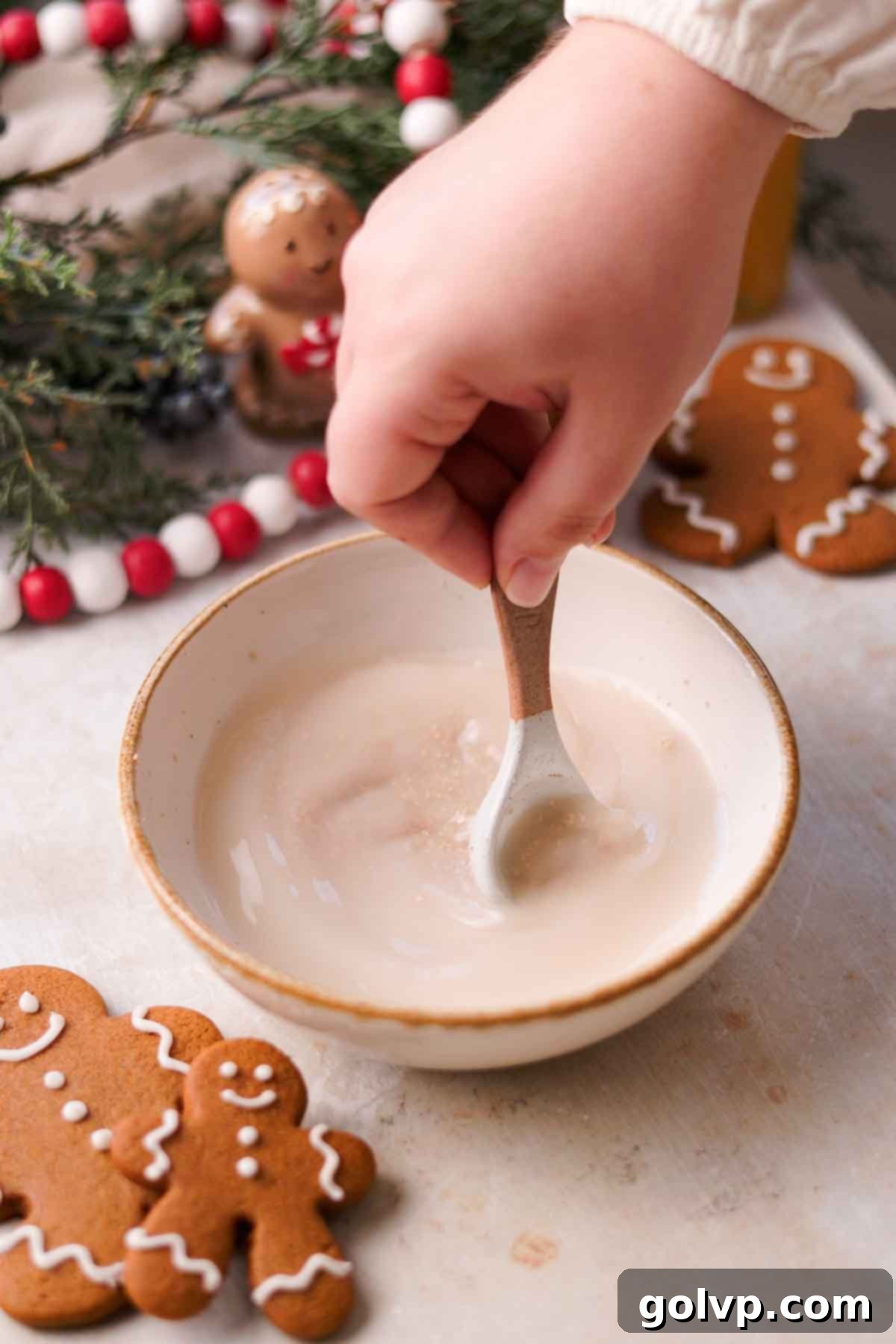
Step 1: Activate the Yeast. In a small bowl, combine warm water (ensure it’s around 105-115°F or 40-46°C, not too hot or cold), 1 teaspoon of granulated sugar, and the active dry yeast. Stir gently until the yeast granules are fully dissolved. Let this mixture sit undisturbed for about 5 minutes. You’re looking for a foamy layer to form on top, which indicates the yeast is active and alive. If no foam appears after 10 minutes, discard the mixture and try again with a fresh packet of yeast, as inactive yeast will prevent your dough from rising.
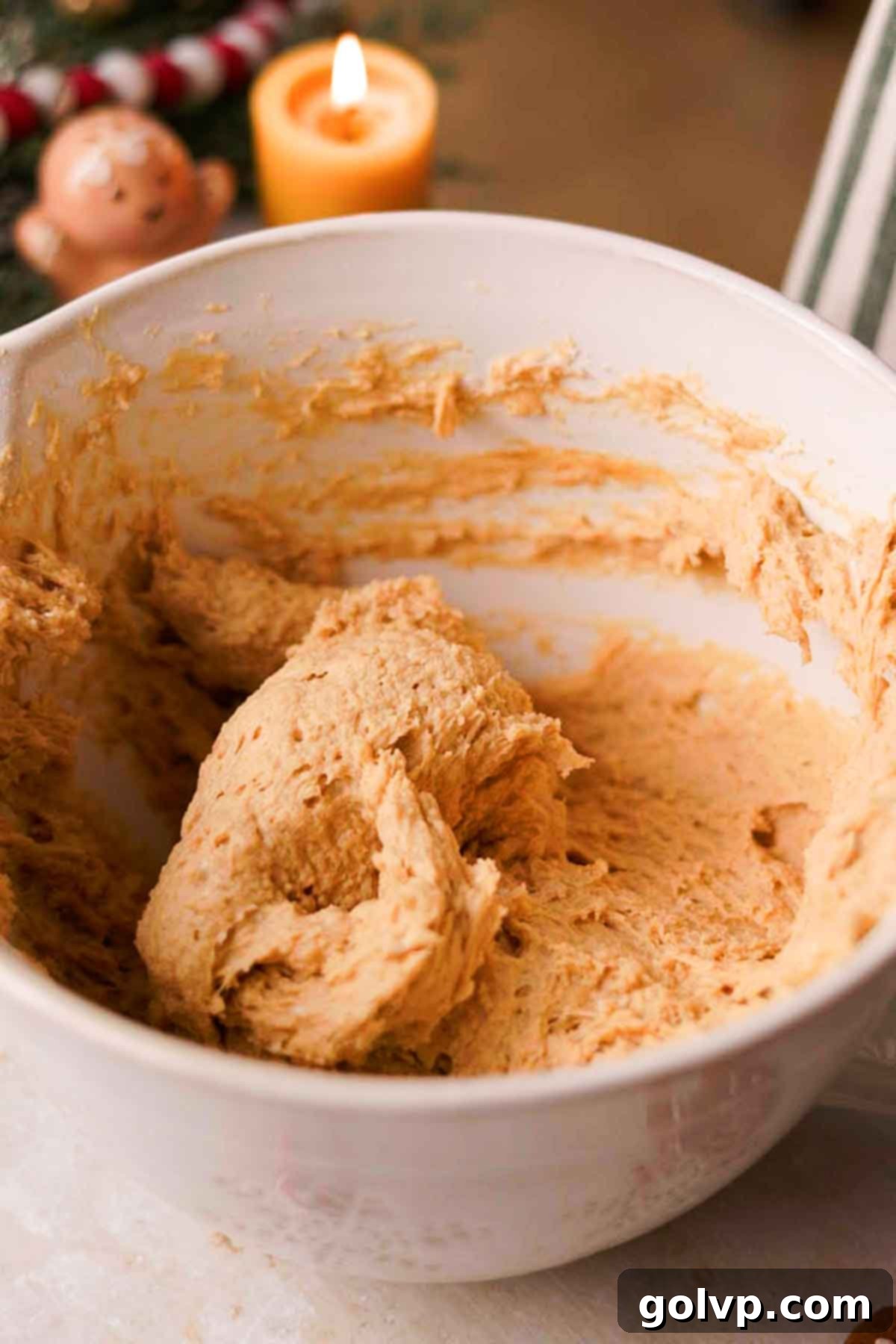
Step 2: Prepare and Rise the Dough. In a large mixing bowl, combine the accurately measured all-purpose flour and sea salt; stir them together until well combined. Create a small well in the center of the dry ingredients. Pour in the molasses, softened butter, room temperature eggs, vanilla extract, warm milk, and your activated yeast mixture from Step 1. Mix everything together with a sturdy spoon or spatula until a cohesive, slightly sticky dough forms. Avoid overmixing; just enough until no dry flour streaks remain. Cover the bowl snugly with a clean dishcloth and place it in a warm, draft-free spot (refer to the “Expert Tips” section for ideal rising conditions) to rise until it has visibly doubled in size, which typically takes about 45 minutes, depending on your room temperature.
While the dough rises: Take this time to butter a 9” by 12” baking pan generously, ensuring every corner is coated. Then, prepare your delicious gingerbread filling by mixing all the specified filling ingredients together in a separate bowl until well combined and smooth. Set both aside.
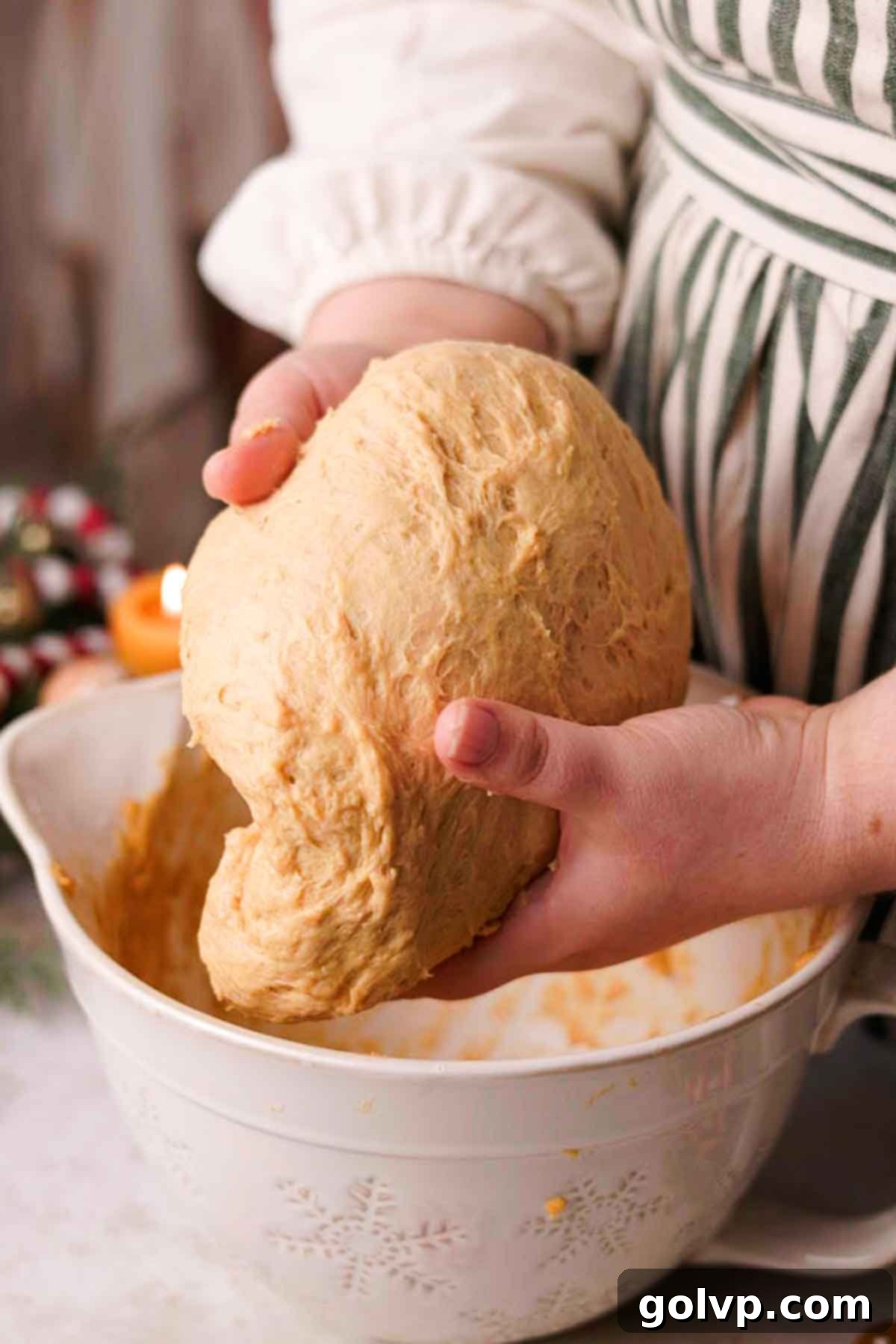
Step 3: Punch Down and Prepare Dough. Once your dough has successfully risen and doubled in size, gently punch it down to release the trapped air. Give it a few light folds within the bowl to bring it together until it feels smooth and elastic. Transfer the dough onto a lightly floured surface (too much flour will make the rolls dry).
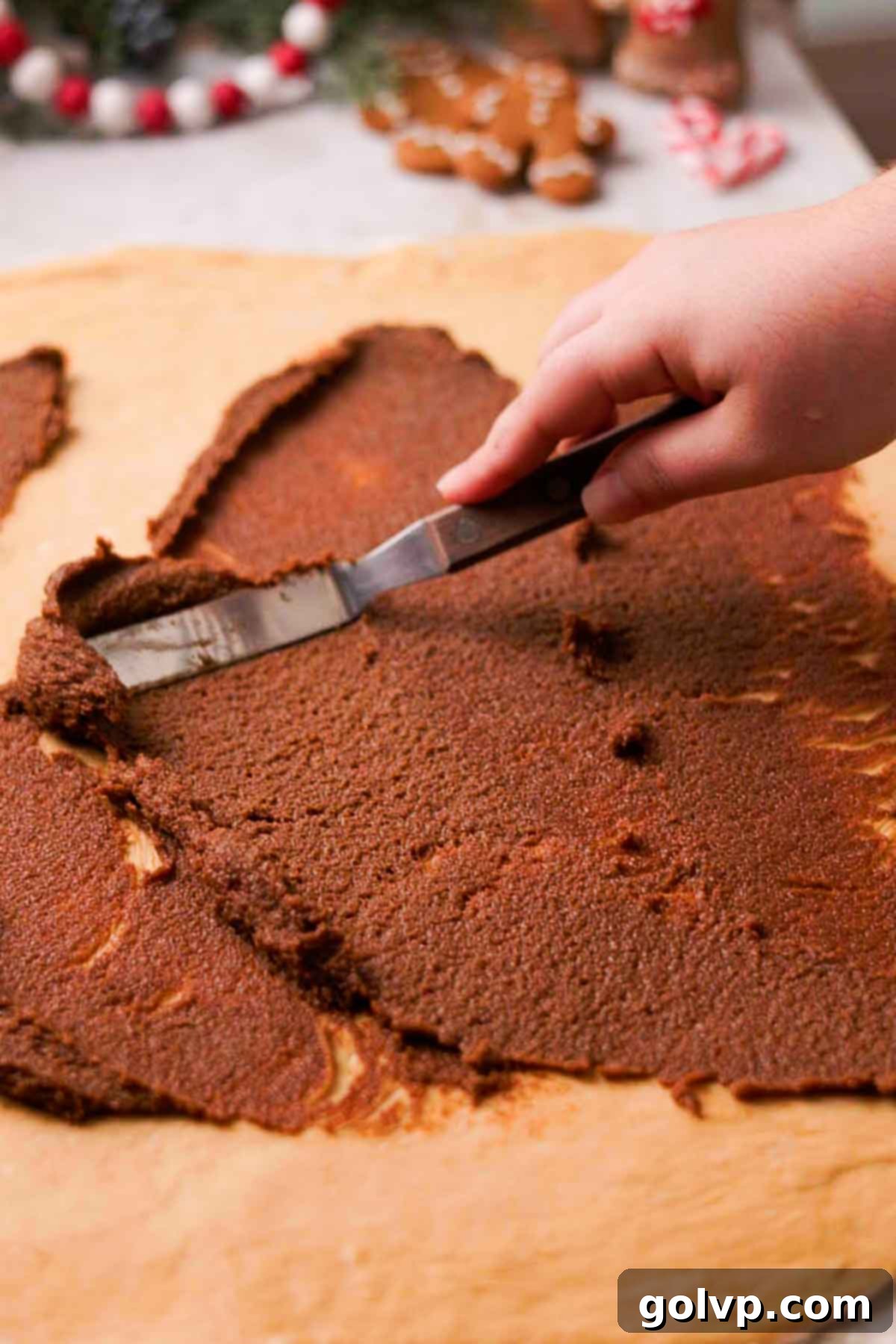
Step 4: Roll and Fill. Using a rolling pin, gently roll the dough into a large rectangle, aiming for dimensions of approximately 18” by 24”. Strive for an even thickness across the entire rectangle. Once rolled, generously and evenly spread the prepared gingerbread filling over the entire surface of the dough, leaving a small border (about ½ inch) along one of the long edges to help seal the roll.
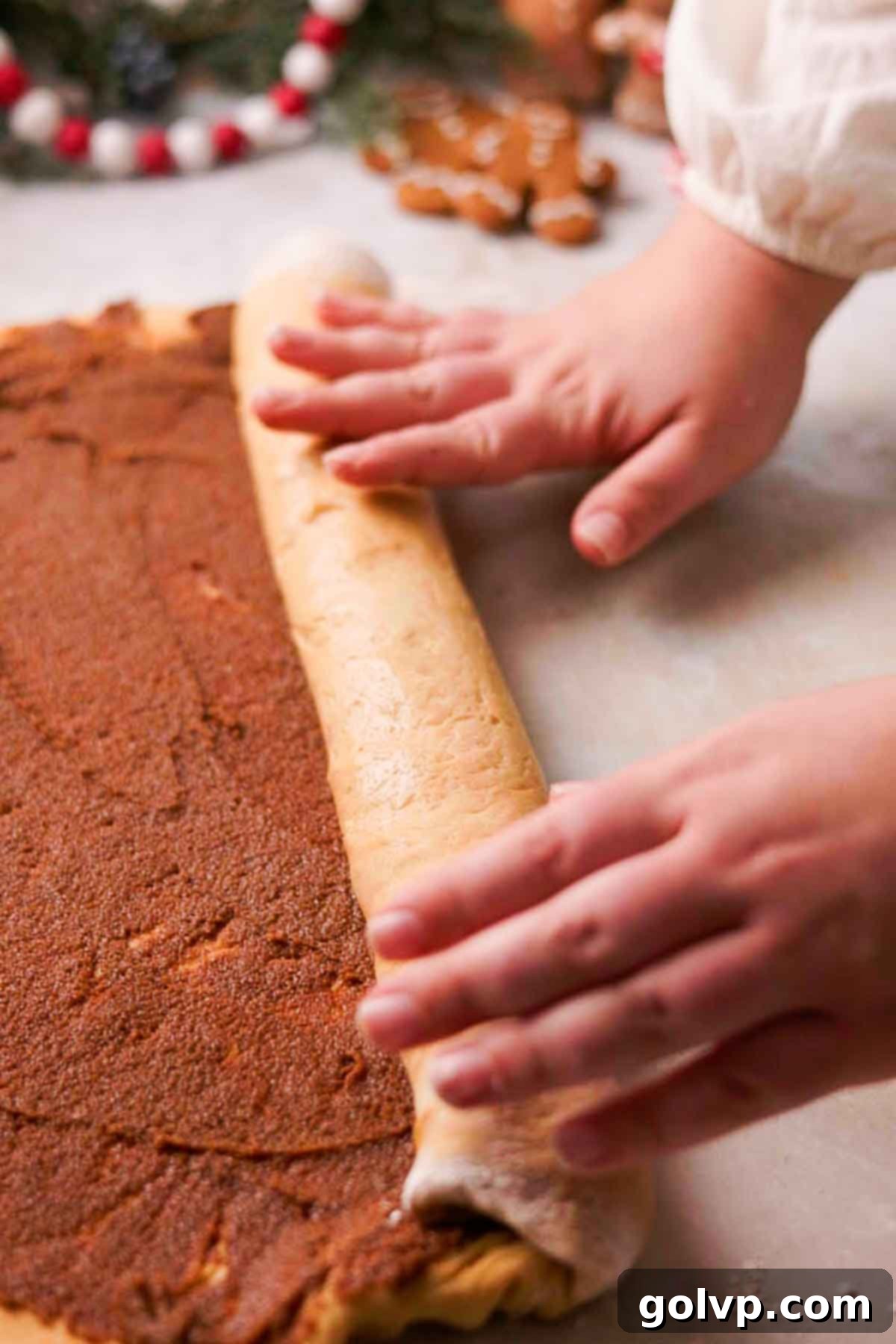
Step 5: Roll into a Log and Mark. Carefully begin rolling the dough from one of the long edges, starting at the bottom. Roll it up tightly into a neat log. Once rolled, use a ruler or visual estimation to mark the log into 12 equal pieces. This ensures uniform roll sizes for even baking.
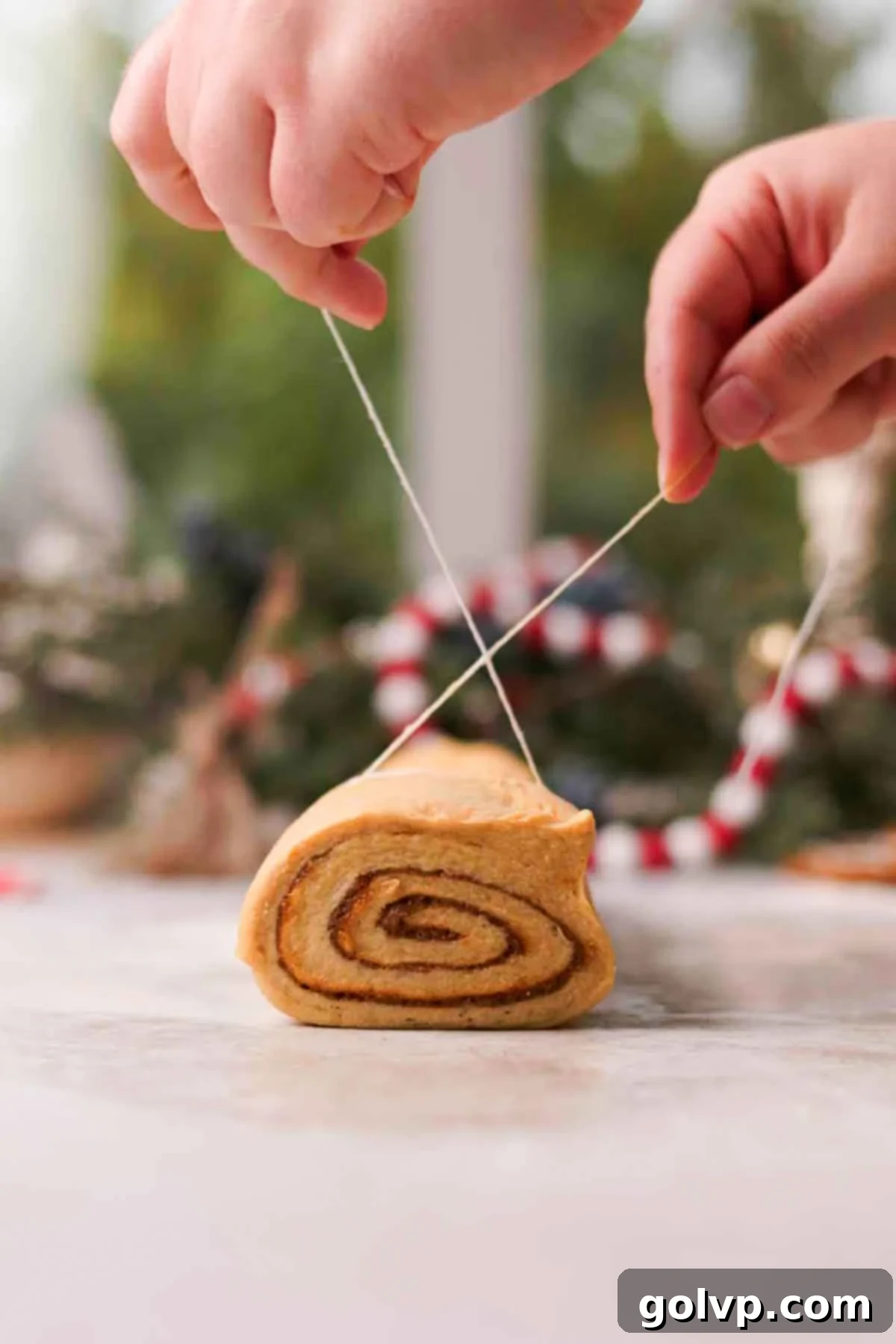
Step 6: Cut and Second Rise. For the cleanest cuts that maintain the rolls’ beautiful spiral shape, use a piece of unflavored dental floss or a thin cotton string. Slide the string underneath the log at each marked point, cross the ends over the top, and pull firmly to cut through the dough. Arrange each cut roll snugly into your prepared baking pan. Cover the pan again with a dishcloth and place it in a warm area for a second rise until the rolls have visibly doubled in size and filled out the pan, approximately 30 minutes.
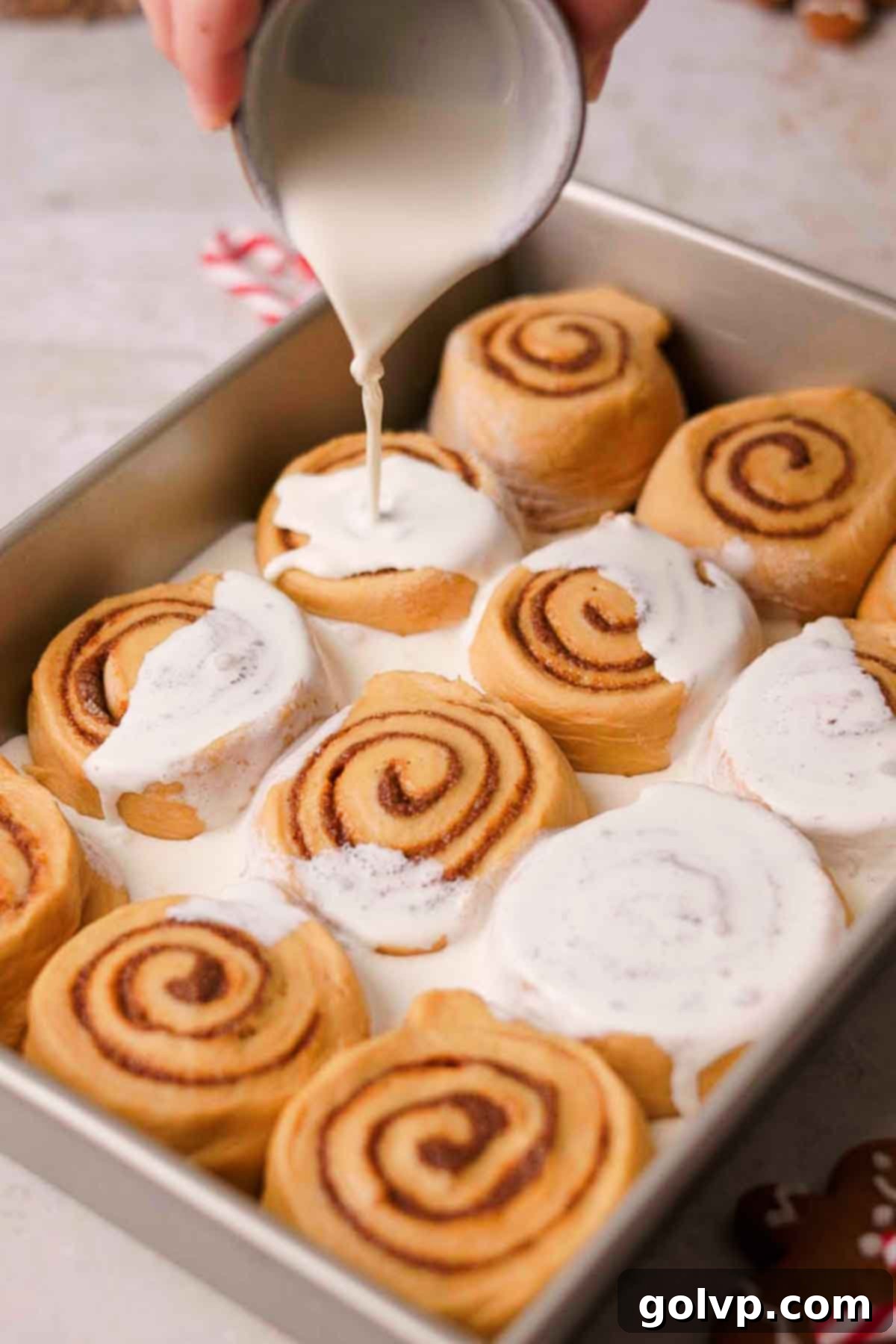
Step 7: Prepare for Baking. While your rolls are undergoing their second rise, preheat your oven to 355°F (180°C). Once the rolls have risen beautifully, gently pour the heavy cream evenly over the top of all the rolls in the baking pan. This step is crucial for achieving that incredible gooeyness and moist texture.
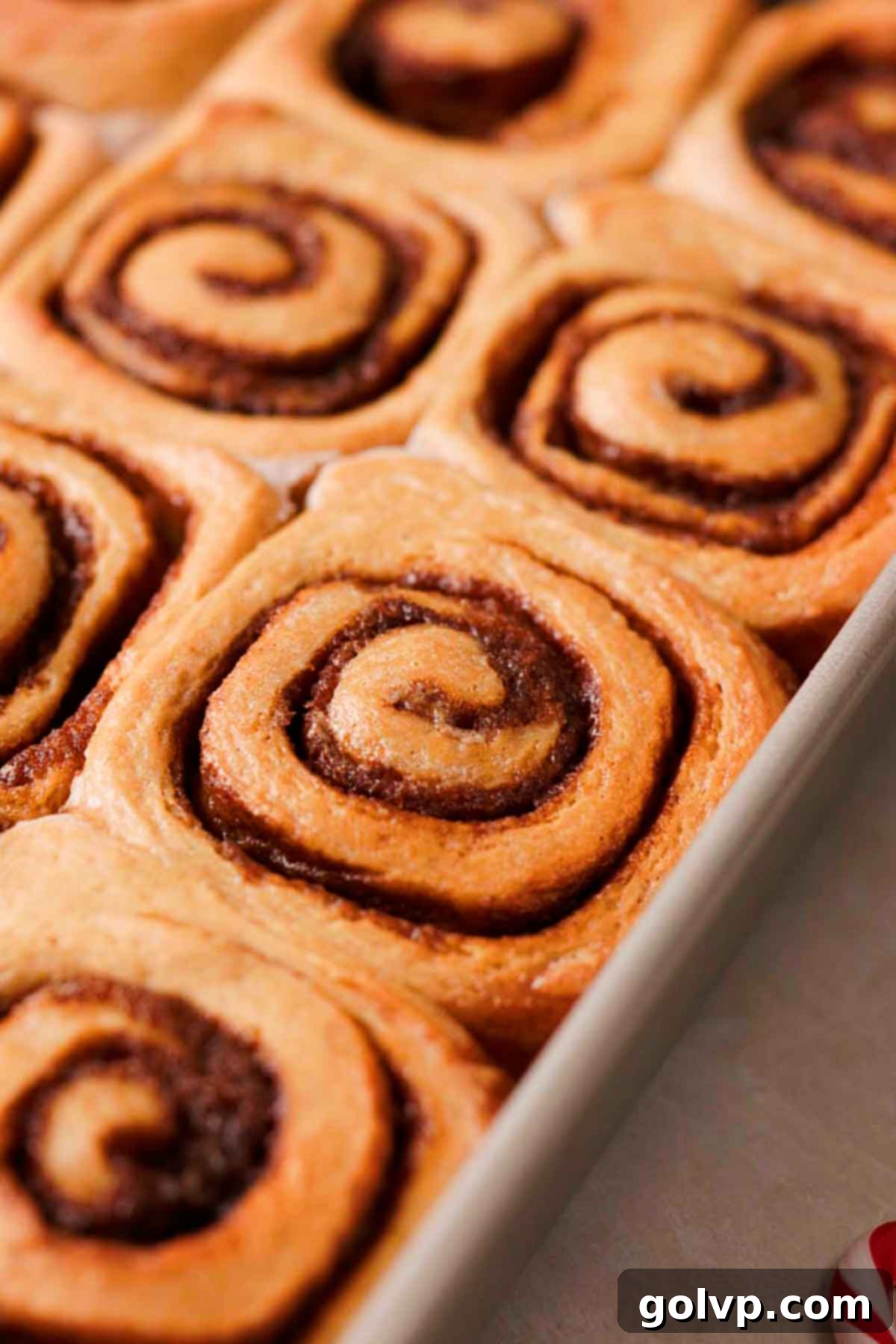
Step 8: Bake and Cool. Carefully place the pan into the preheated oven and bake for 25-30 minutes, or until the tops of the rolls are beautifully golden brown and the centers are cooked through. Keep an eye on them to prevent over-browning. Once baked, remove the pan from the oven and let the rolls cool slightly in the pan while you prepare the irresistible cream cheese frosting.
Cream Cheese Frosting Step-by-Step
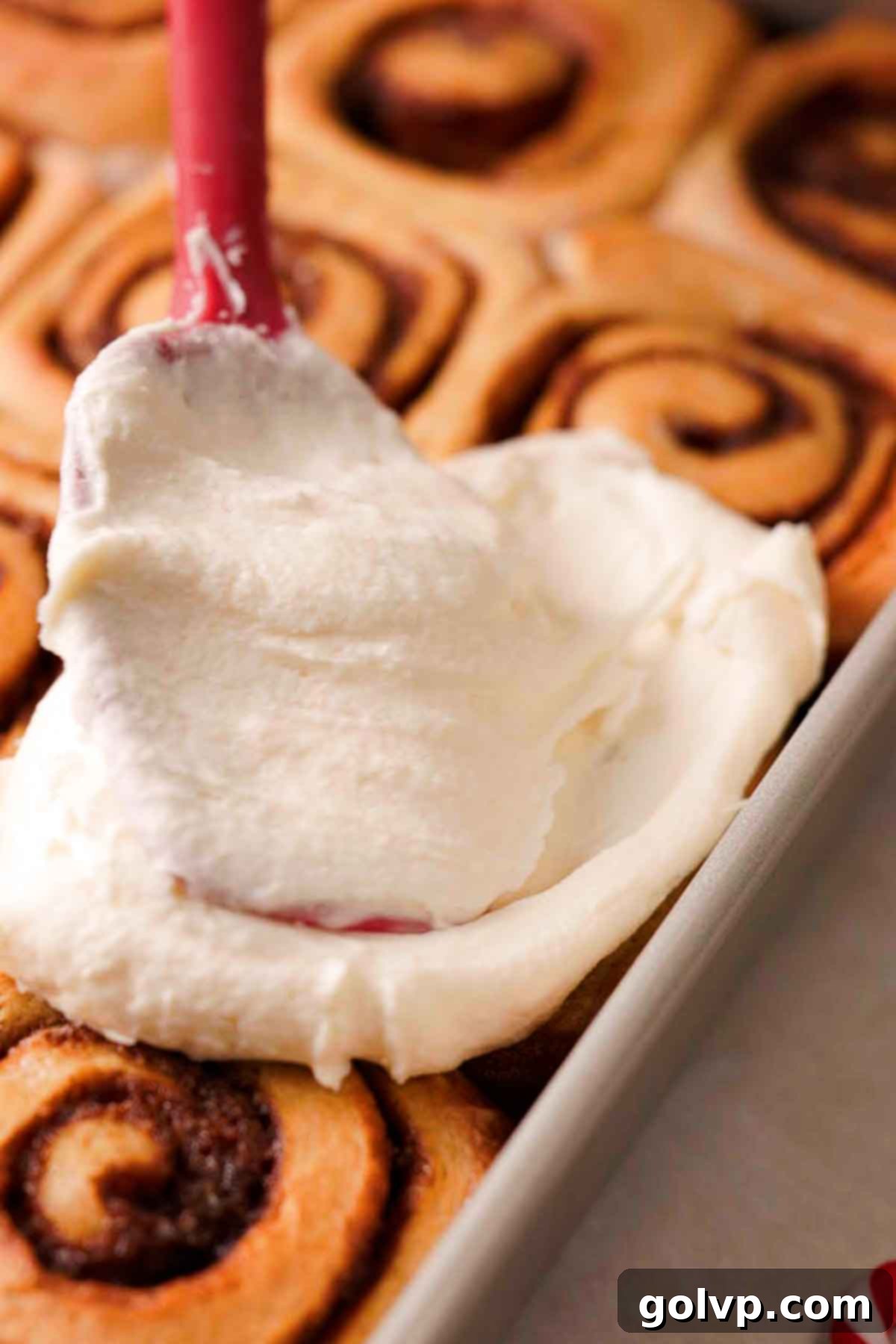
Step 1: Whip the Base. In the bowl of a stand mixer fitted with a paddle attachment, or using an electric hand mixer, combine the softened unsalted butter, powdered sugar, and sea salt. Beat on medium-high speed until the mixture is incredibly light, airy, and fluffy, scraping down the sides of the bowl as needed. This usually takes about 2-3 minutes.
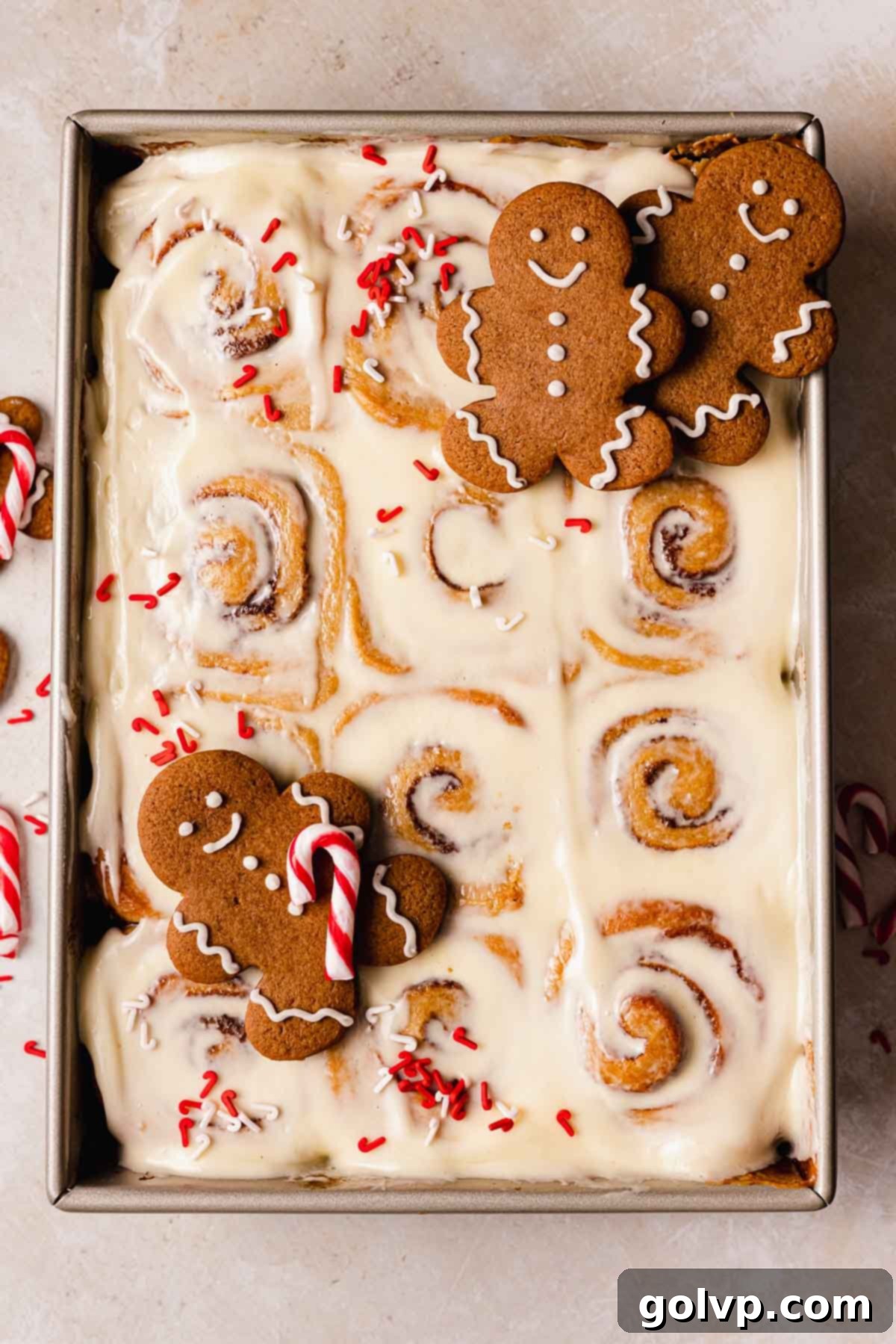
Step 2: Add Cream Cheese and Finish. Reduce the mixer speed to low. Add the pure vanilla extract and the softened cream cheese in several small chunks, adding one chunk at a time and beating well after each addition until fully incorporated and smooth. Increase the speed to medium-high again and beat until the frosting is perfectly fluffy and smooth, with no lumps. Spread this glorious frosting generously over the gingerbread cinnamon rolls while they are still warm. This allows the frosting to slightly melt and seep into all the delicious crevices. Serve immediately and enjoy them warm!
✔️ Expert Tips for Fluffy & Gooey Cinnamon Rolls
- Always Dissolve Yeast Separately: This initial step is a critical “proof of life” for your yeast. By combining it with warm water and a pinch of sugar, you’re giving it ideal conditions to activate. If a foamy layer doesn’t form on top within 5-10 minutes, your yeast is likely inactive. Don’t proceed with it; discard and use a fresh packet to avoid flat, dense rolls. This simple check saves you time and ingredients!
- Measure Flour with Precision: The amount of flour is crucial for dough consistency. For the most accurate results, use a kitchen scale (600g is specified). If a scale isn’t available, avoid scooping flour directly from the bag, which can compact it and add too much. Instead, gently fluff the flour with a spoon, then spoon it into your measuring cup. Level off the top with the flat edge of a knife, without packing it down. This ensures you’re using the correct volume.
- Resist Over-Kneading the Dough: This is a “no-knead” recipe for a reason! Unlike traditional yeast doughs, this one benefits from minimal mixing. You only need to mix until the ingredients are just combined and no dry flour streaks remain. Over-mixing will develop too much gluten, resulting in a tough, chewy, and less tender cinnamon roll.
- Use Unflavored Floss or Cotton String for Cutting: Cutting soft dough with a knife can squish the rolls and ruin their beautiful spiral shape. Unflavored dental floss or a thin cotton string provides a much cleaner, more precise cut. Simply slide the string under the dough log, cross the ends, and pull gently to slice through. This technique keeps the rolls perfectly round and intact.
- Never Skip the Dough’s Rising Time: Patience is a virtue in baking, especially with yeast doughs. The rising periods are essential for several reasons: they allow the flour to fully hydrate, the yeast to ferment and create air pockets, and the gluten to relax. Skipping or shortening these rises will result in dense, heavy rolls that lack that characteristic fluffy texture. Ensure your rising environment is warm and draft-free for optimal results.
🥄 Storing and Reheating Leftover Gingerbread Cinnamon Rolls
These baked gingerbread cinnamon rolls are best enjoyed fresh, but any leftovers can be stored to maintain their deliciousness. Place them in an airtight container or wrap them tightly with plastic wrap to prevent them from drying out. They will keep well in the refrigerator for up to 4 days.
For longer storage, you can freeze the baked rolls. Wrap them individually or in a tightly sealed freezer-safe container. They can be stored in the freezer for up to 2 months. When you’re ready to enjoy them, thaw overnight in the refrigerator if frozen.
I highly recommend gently reheating any leftover rolls before serving. A quick warm-up in the microwave (30-60 seconds per roll) or a few minutes in a preheated oven (300°F/150°C for 5-10 minutes, covered with foil) will make them incredibly soft, gooey, and taste as if they were freshly baked. The frosting will melt into the rolls, enhancing their texture and flavor.
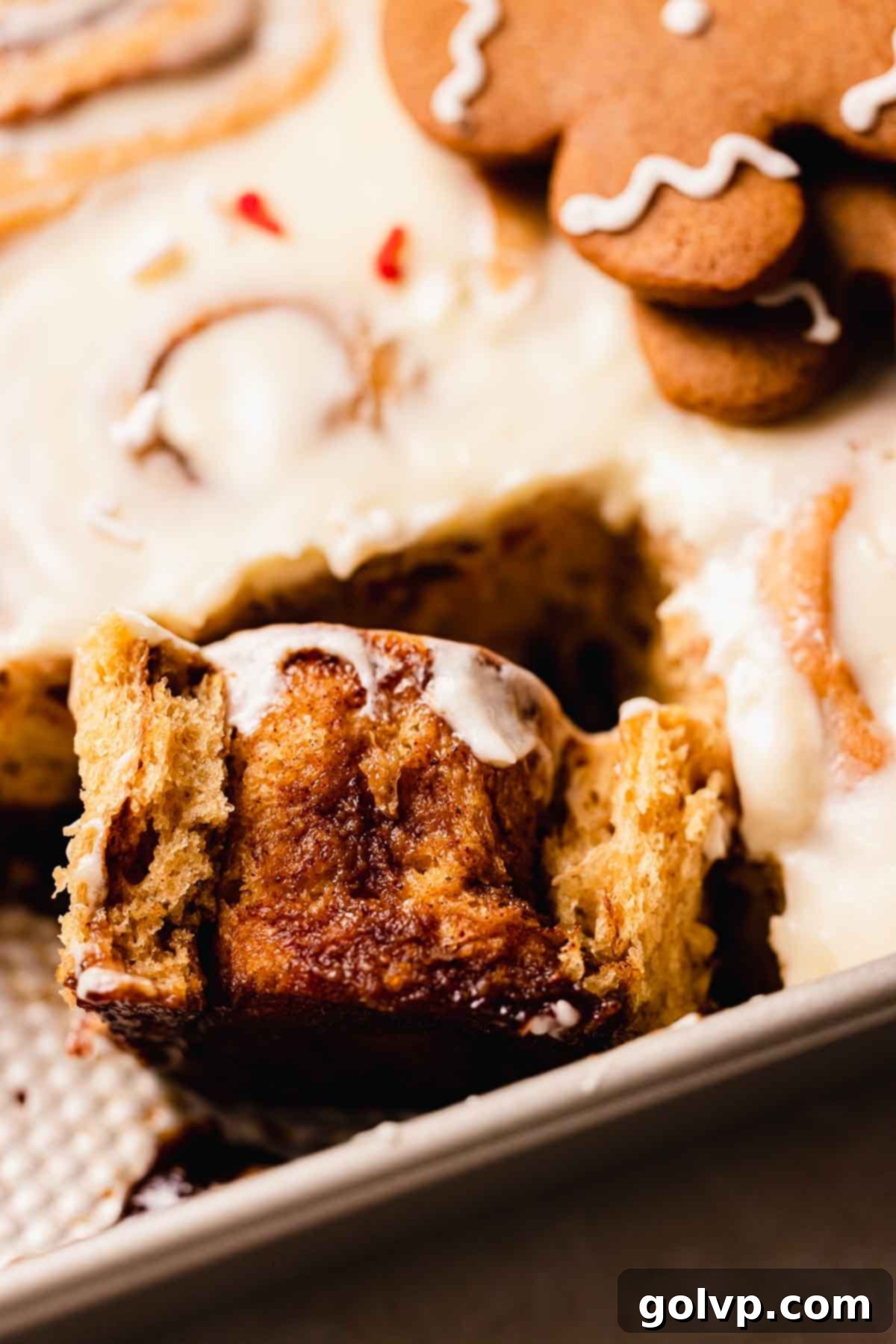
😴 How to Make Overnight Gingerbread Cinnamon Rolls (Make-Ahead Option)
To simplify your holiday morning or make entertaining a breeze, this recipe includes a fantastic overnight option for these gingerbread cinnamon rolls. Enjoy the luxury of freshly baked rolls without the morning rush!
To prepare them the night before, follow all the recipe instructions up to the point of the second rise (after the rolls have been cut and arranged in the baking pan). Instead of letting them rise at room temperature, wrap the baking tray tightly with plastic wrap or aluminum foil, ensuring it’s airtight. Immediately place the wrapped tray in the refrigerator for up to 12 hours. The cold temperature will slow down the yeast activity, allowing the dough to slowly develop flavor overnight.
The next morning, remove the tray with the rolls from the refrigerator and uncover them. Depending on how much they’ve risen in the fridge, you may need to let them come to room temperature and rise for an additional 30-60 minutes, or until they have puffed up and filled out any remaining gaps in the pan. This step is crucial for achieving light and fluffy rolls.
Once they’ve reached the desired size, proceed with pouring the heavy cream over the rolls before baking and follow the remaining baking and frosting instructions as outlined in the recipe. This make-ahead method guarantees warm, delicious gingerbread cinnamon rolls with minimal effort on the day of serving.
🎅 How to Infuse Desserts with Authentic Gingerbread Flavor
Achieving that iconic, deep gingerbread flavor is all about the right balance of molasses and fresh, potent spices. I’ve refined this recipe through several iterations to truly make that gingerbread taste pop!
The star of the show for gingerbread flavor is, without a doubt, **molasses**. Our filling features a generous amount of dark molasses, which imparts a rich, complex sweetness and a distinctive depth that is crucial to the gingerbread profile. I specifically use dark molasses because it offers the perfect intensity – not as mild as light molasses, and not as bitter or overwhelming as blackstrap molasses. When I initially experimented without molasses, the rolls were tasty but tasted merely like “spiced” cinnamon rolls, missing that authentic, cozy gingerbread essence.
Beyond the filling, a subtle touch of molasses is also incorporated into the dough itself. This adds a foundational layer of that classic deep flavor without making the dough itself too heavy or overpowering. Dark molasses is also the most commonly found type in most grocery stores, making it easy to source.
Equally important are **fresh spices**. The blend of ground ginger, cinnamon, cloves, and nutmeg creates the warmth and aromatic complexity synonymous with gingerbread. It’s vital to use spices that are not expired or stale. Spices lose their flavor and potency the longer they sit, especially once opened. To preserve their vibrant aroma and taste, store any opened spices in airtight containers, away from direct sunlight and heat. Using fresh spices ensures every bite is packed with that quintessential holiday cheer.
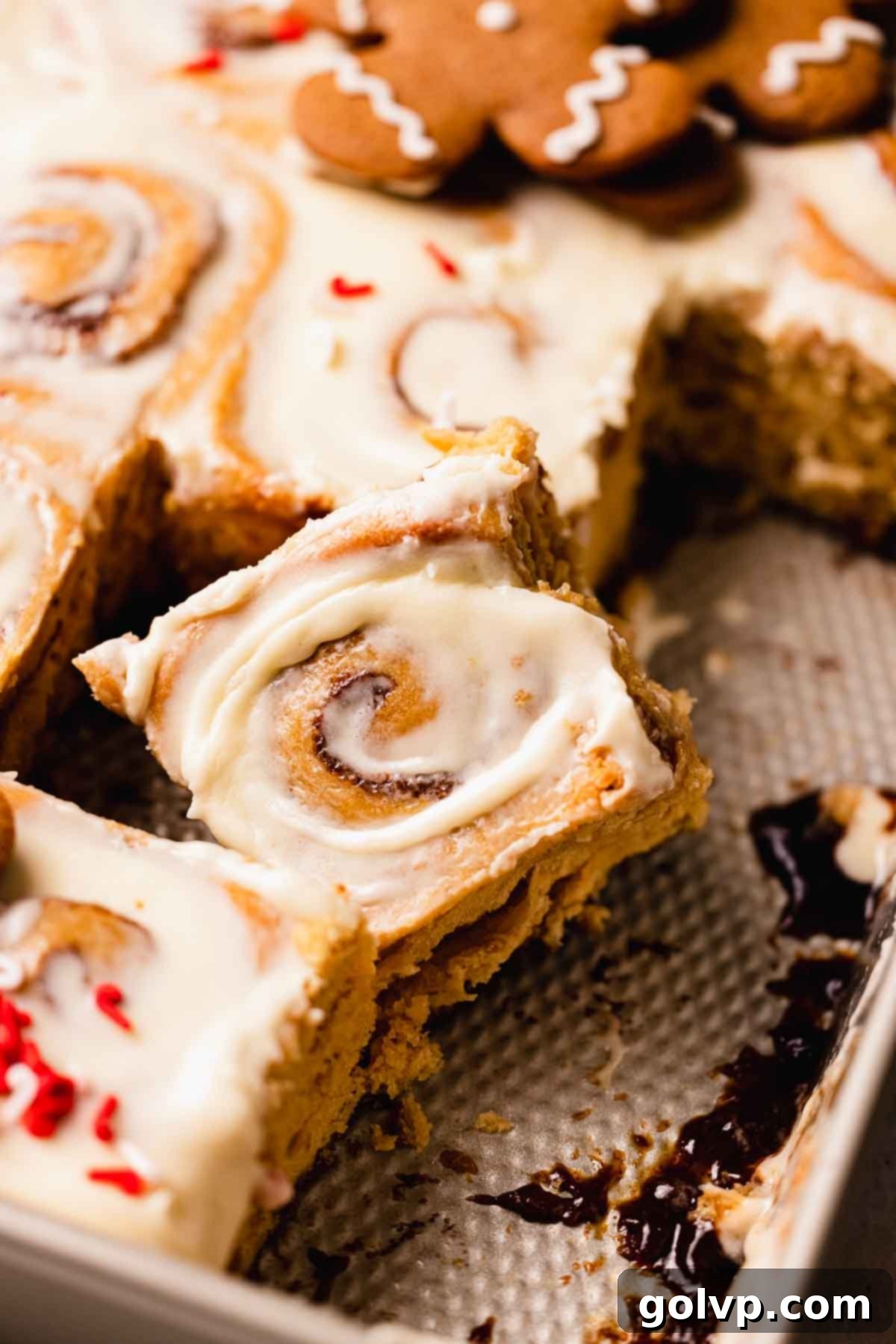
🍞 The Secret to Making Ultra Gooey Gingerbread Cinnamon Rolls
Achieving that coveted, melt-in-your-mouth, ultra-gooey texture is a signature of these gingerbread cinnamon rolls, and it comes down to a simple, yet transformative technique: a generous pour of heavy whipping cream. Just before sliding the pan into the oven, we drench the rolls in heavy cream.
Here’s the magic behind it: As the rolls bake, the heavy cream gently steams them from the bottom up. This steaming action keeps the dough incredibly moist and tender, preventing it from drying out. Simultaneously, the cream mixes with the rich gingerbread filling (packed with brown sugar and molasses) creating an irresistible, caramelized, sticky syrup that pools at the bottom of the pan and seeps into every crevice. This ensures you get those ooey-gooey, sticky bottoms that everyone craves, and guarantees your rolls stay fluffy and moist for days!
The addition of molasses to the filling also plays a dual role in this gooeyness. Beyond its flavor contribution, molasses is a humectant, meaning it helps to retain moisture. This natural property further enhances the sticky, moist texture of the filling, making it even more luscious and scrumptious. The combination of molasses and a symphony of spices truly makes the gingerbread flavor pop, while contributing to the rolls’ incredible gooeyness.
🧁 Classic Cream Cheese Frosting Perfection
These delightful gingerbread cinnamon rolls are perfectly complemented by my go-to classic cream cheese frosting, a recipe I trust for all my cinnamon roll creations. You simply can’t go wrong with its rich, tangy-sweet flavor and luscious texture!
When initially prepared, this frosting is wonderfully thick and incredibly fluffy, making it versatile for different preferences. If you adore a dense, substantial layer of frosting on your rolls, I recommend waiting until the rolls have completely cooled to room temperature before spreading it on. This will allow the frosting to set firmly on top.
However, I personally prefer a cream cheese frosting that is a little more melty and luxurious, allowing it to gently seep into the warm crevices of the rolls. To achieve this desired consistency, I suggest frosting the rolls while they are still warm, shortly after coming out of the oven. For an even more dramatically melted effect, you can even pop the frosted rolls back into the warm (but turned off) oven for a few minutes. This allows the frosting to soften and create that irresistible, seeped-in glaze that makes every bite truly decadent.
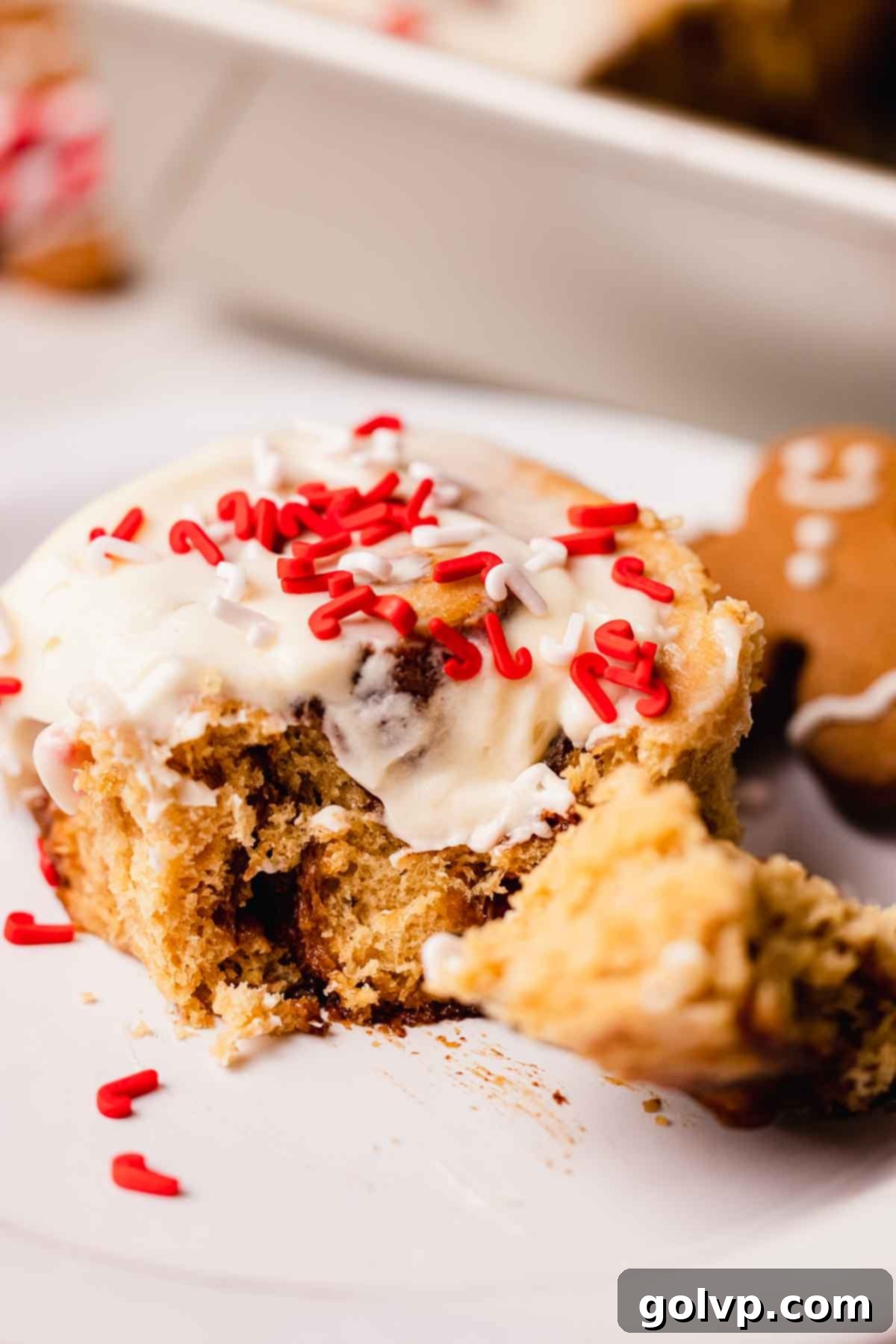
🎁 How to Decorate Festive Christmas Cinnamon Rolls
If you’re bringing these show-stopping gingerbread cinnamon rolls to a Christmas brunch party or serving them as a holiday dessert, why not elevate their festive appeal with some delightful decorations? Deck them out to truly embody the spirit of the season!
Here are some charming ideas:
- Holiday Sprinkles: A colorful assortment of red, green, and white holiday sprinkles instantly adds a cheerful touch. Look for edible glitter or snowflake-shaped sprinkles for an extra magical look.
- Crushed Candy Canes or Peppermints: For a refreshing minty contrast and a burst of color, sprinkle crushed candy canes or peppermints over the frosting.
- Mini Gingerbread Men Cookies: These tiny edible toppers are absolutely adorable and perfectly complement the gingerbread theme. Use this fantastic soft gingerbread cookie recipe to bake miniature gingerbread men that hold their shape beautifully in the oven. They make the cutest and most thematic dessert topper!
- Sugared Cranberries or Rosemary Sprigs: For an elegant, rustic touch, garnish with a few sugared cranberries or small sprigs of fresh rosemary to mimic frosted evergreen branches.
- Orange Zest: A delicate sprinkle of fresh orange zest can add a bright, aromatic counterpoint to the rich spices.
Expert Decorating Tip: If you plan to decorate with sprinkles, wait until just before serving. Sprinkles, especially those with darker colors, have a tendency to “bleed” into the frosting if left sitting for too long, which can make your beautifully frosted rolls look messy. Apply them fresh for maximum visual impact!
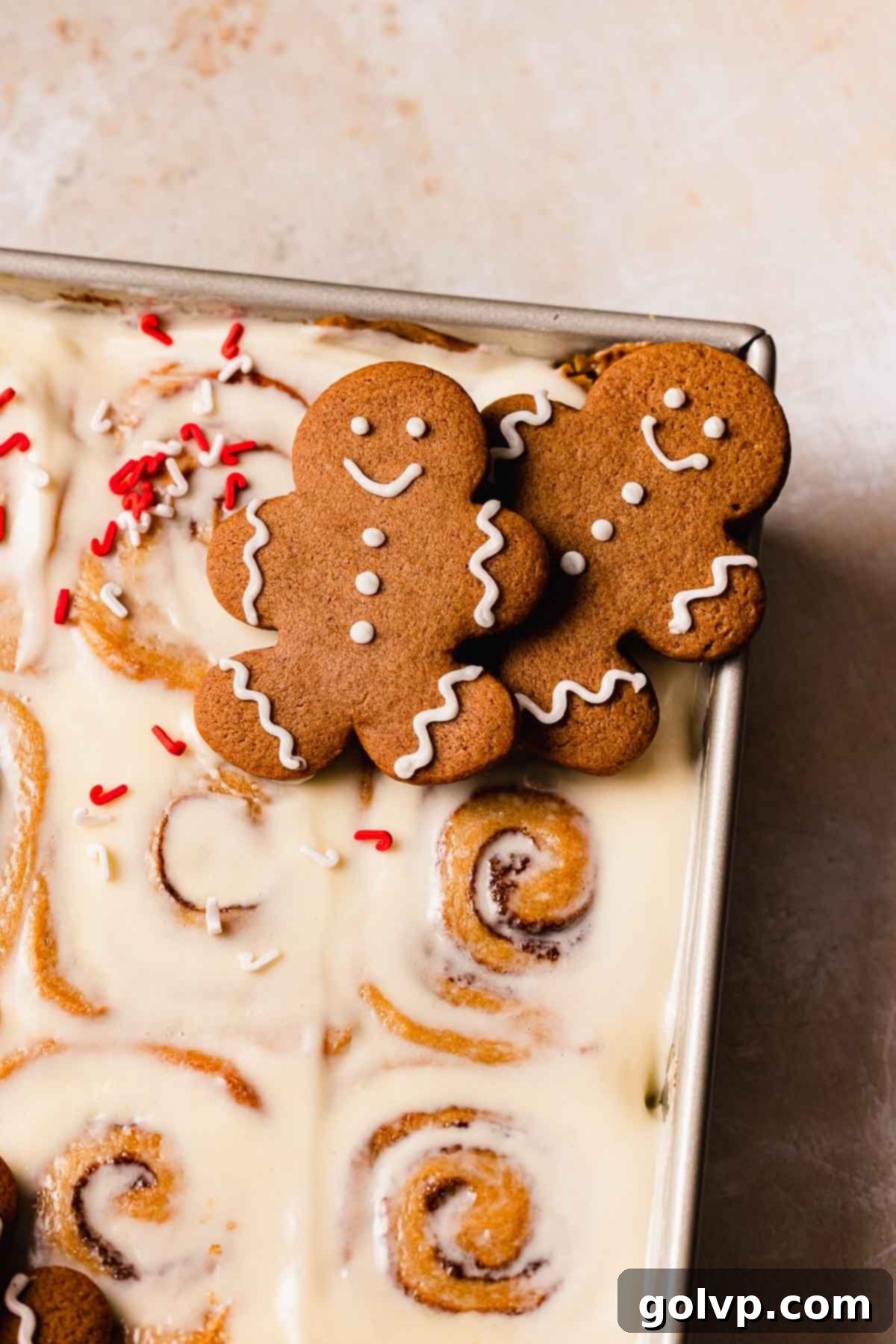
📖 Recipe FAQs About Gingerbread Cinnamon Rolls
For baking gingerbread, particularly these cinnamon rolls, **dark molasses** is highly recommended. It offers the perfect balance of richness, depth, and a slightly smoky sweetness that is characteristic of authentic gingerbread flavor. While blackstrap molasses can also be used in baking, it is significantly darker and has a much more bitter, robust flavor that can easily overwhelm the delicate spice profile of the rolls, so I generally do not prefer it for this recipe. Light molasses, conversely, might not provide enough depth.
Yes, it’s quite normal for no-knead dough, especially this recipe, to be very sticky and somewhat wet right after all the ingredients are combined. This high hydration contributes to the final soft and tender texture of the rolls. As the flour absorbs more liquid during the initial resting and rising period, the dough will become less sticky and more manageable, resembling a proper dough rather than a batter. However, if your dough appears excessively runny, almost like a pancake batter rather than a sticky dough, you may need to add a very small amount of additional all-purpose flour (1-2 tablespoons at a time) until it reaches a more cohesive, albeit still sticky, consistency.
I strongly advise against omitting the molasses in this recipe. Molasses is a critical ingredient for two main reasons: firstly, it’s absolutely essential for imparting that distinctive, rich, and authentic gingerbread flavor that defines these rolls. Without it, they would taste more like spiced cinnamon rolls rather than true gingerbread. Secondly, molasses acts as a humectant, helping to create the ultra-gooey and moist texture in both the dough and, especially, the filling. Skipping it would result in a less flavorful and potentially drier, less gooey roll.
For the most authentic and well-rounded gingerbread flavor, I highly recommend using all the spices listed: ground ginger, cinnamon, cloves, and nutmeg. Each spice contributes a unique layer of warmth and aroma to the overall profile. If you absolutely must omit one due to availability or preference, you certainly can – however, be aware that the gingerbread flavor might be less complex, a bit more subtle, and not as deep or traditional. For example, ginger and cinnamon are arguably the most crucial for the core “gingerbread” taste.
🎄 More Related Holiday Recipes:
- Soft Gingerbread Cookies
- Blueberry Cinnamon Rolls
- Gingerbread Cupcakes
- Cinnamon Roll Muffins
Did you make this recipe? I would love for you to rate this recipe and hear what you think in the comments below! Share your creation on Instagram and tag @flouringkitchen. Follow me on Pinterestto save and for more recipe ideas.
📖 Recipe
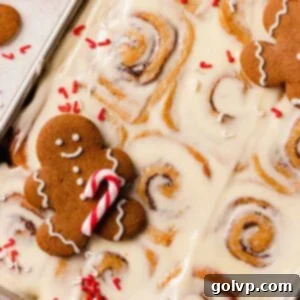
Gingerbread Cinnamon Rolls [No Knead]
Mary
Pin Recipe
Shop Ingredients
Equipment
-
9″ by 12″ baking tray
Ingredients
Dough
- ½ cup water warm
- 1 teaspoon granulated sugar
- 1 packet active dry yeast 7g or 2 ¼ teaspoons
- 5 cups all purpose flour 600g
- ¼ teaspoon sea salt
- 2 tablespoons molasses unsulphured, not blackstrap
- ¼ cup brown sugar packed
- ¾ cup unsalted butter softened
- 2 large eggs room temperature
- 1 tablespoon pure vanilla extract
- ½ cup milk warm
- ½ cup heavy whipping cream
Filling
- ½ cup unsalted butter very soft but not melted
- 1 cup dark brown sugar packed
- 3 tablespoons molasses
- ¼ teaspoon sea salt
- 1 ½ tablespoons cinnamon ground
- 2 teaspoons ginger ground
- ½ teaspoon cloves ground
- ½ teaspoon nutmeg ground
Frosting
- ½ cup unsalted butter softened
- 2 cups powdered sugar
- ¼ teaspoon sea salt
- 1 teaspoon pure vanilla extract
- 4 oz cream cheese softened
Shop Ingredients on Jupiter
Instructions
Dough Preparation
-
In a small bowl, combine the warm water (ensure it’s around 105-115°F/40-46°C), 1 teaspoon of granulated sugar, and the active dry yeast. Stir gently until the yeast dissolves completely. Let the mixture sit for about 5 minutes; a foamy layer should form on top, indicating the yeast is active. If no foam appears after 10 minutes, discard and try again with a fresh packet of yeast.½ cup water, 1 teaspoon granulated sugar, 1 packet active dry yeast
-
In a large bowl, combine the sifted all-purpose flour and sea salt; stir well. Create a well in the center and add the molasses, brown sugar, softened butter, room temperature eggs, vanilla extract, warm milk, and the activated yeast mixture.5 cups all purpose flour, ¼ teaspoon sea salt, 2 tablespoons molasses, ¼ cup brown sugar, ¾ cup unsalted butter, 2 large eggs, 1 tablespoon pure vanilla extract, ½ cup milk
-
Mix until a cohesive, slightly sticky dough forms. Cover the bowl with a dish cloth and place in a warm, draft-free spot (see notes for tips) to rise until doubled in size, about 45 minutes.
Gingerbread Filling
-
Ensure the butter is very soft, almost at a creamy consistency, to blend easily. In a medium bowl, combine all the filling ingredients and mix well until fully combined and smooth. Set aside for later use.½ cup unsalted butter, 1 cup dark brown sugar, 3 tablespoons molasses, ¼ teaspoon sea salt, 1 ½ tablespoons cinnamon, 2 teaspoons ginger, ½ teaspoon cloves, ½ teaspoon nutmeg
Assembly & Baking
-
Generously butter a 9” by 12” baking pan with a bit of cold butter, ensuring thorough coverage, and set it aside.
-
Once the dough has risen, gently punch it down to release air. Transfer it onto a lightly floured surface. Using a rolling pin, roll the dough into a large rectangle, approximately 18” by 24”, striving for even thickness. Evenly spread the gingerbread filling over the entire surface of the rolled dough, leaving a small border on one long edge.
-
Starting from the bottom long edge, carefully roll the dough into a tight log. Once rolled, use a ruler or visual estimation to mark the log into 12 equal pieces to ensure consistent roll sizes.
-
For clean cuts, slide a piece of unflavored dental floss or cotton string underneath the log at each marked point. Cross the ends of the string over the top and pull firmly to cut through the dough. Arrange each cut roll snugly into the buttered baking pan.
-
Preheat your oven to 355°F (180°C). While the oven preheats, let the rolls rise again in a warm place until they puff up significantly and fill out the pan, typically about 30 minutes.
-
Evenly pour the heavy cream over the risen rolls in the pan. Bake for 25-30 minutes, or until the rolls are golden brown on top and cooked through. Let them cool slightly in the pan while you prepare the frosting.½ cup heavy whipping cream
Cream Cheese Frosting
-
In a stand mixer with a paddle attachment or using an electric hand mixer, beat the softened butter, powdered sugar, and sea salt on medium-high speed until the mixture is light, airy, and fluffy, scraping down the bowl as needed.½ cup unsalted butter, 2 cups powdered sugar, ¼ teaspoon sea salt
-
Reduce mixer speed to low. Add the pure vanilla extract and softened cream cheese in several small chunks, beating thoroughly after each addition until smooth. Increase speed to medium-high and beat until the frosting is fluffy.1 teaspoon pure vanilla extract, 4 oz cream cheese
-
Generously spread the frosting on top of the rolls while they are still warm. This allows the frosting to melt slightly and seep into the delicious crevices, creating an extra gooey finish. Serve warm and enjoy!
Video
Notes
Best Way to Let Dough Rise: Finding a warm, draft-free spot is key for successful dough rising. If your kitchen is cool, a great trick is to turn your oven to its lowest temperature (e.g., 170°F or 75°C) for just one minute, then immediately turn it off. This creates a slightly warm environment. Place your covered dough bowl in the oven. The internal temperature should be no higher than 130°F (55°C); anything hotter will kill the yeast, so ensure it’s just warm, not hot.
Overnight Gingerbread Cinnamon Rolls (Make-Ahead): To enjoy these fresh in the morning, prepare the rolls the night before. Stop after you’ve cut and arranged the rolls in the baking pan (before the second rise). Wrap the baking tray tightly with plastic wrap or aluminum foil and immediately place it in the refrigerator for up to 12 hours. The next morning, remove the tray, uncover, and let the rolls come to room temperature and finish rising (they should puff up and fill out the pan). This could take 30-60 minutes depending on your room’s temperature. Once risen, pour heavy cream over them and bake according to the main instructions.
Tips for Success Overview:
- Always activate your yeast in warm water with a touch of sugar first to ensure it’s alive.
- Measure your flour accurately, preferably with a kitchen scale, to maintain proper dough consistency.
- Avoid over-kneading the dough; it’s a no-knead recipe that becomes tough with excessive handling.
- Use unflavored dental floss or a thin cotton string for clean, even cuts without squishing the rolls.
- Do not skip the rising times for the dough; these are essential for achieving light, fluffy, and tender cinnamon rolls.
Nutrition
